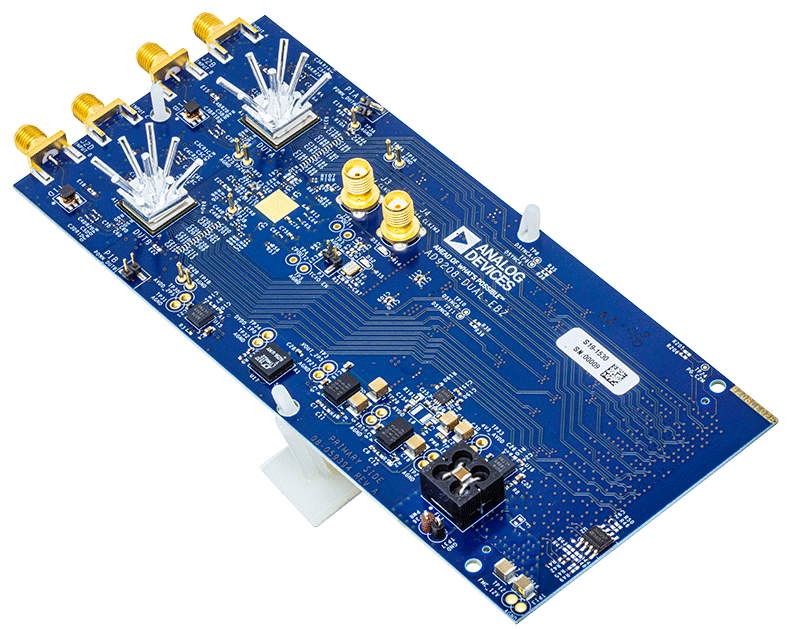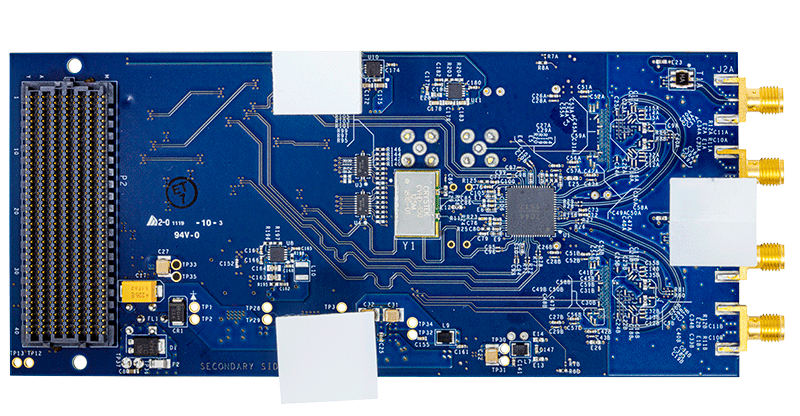AD9699
RECOMMENDED FOR NEW DESIGNS14-Bit, 3 GSPS, JESD204B, Single Analog-to-Digital Converter
- Part Models
- 4
- 1ku List Price
- Starting From $545.70
Part Details
- JESD204B (Subclass 1) coded serial digital outputs
- Support for lane rates up to 16 Gbps per lane
- 2 W total power at 3 GSPS (default settings)
- Performance at −2 dBFS amplitude, 2.6 GHz input
- SFDR = 70 dBFS
- SNR = 57.2 dBFS
- Performance at −9 dBFS amplitude, 2.6 GHz input
- SFDR = 78 dBFS
- SNR = 59.5 dBFS
- Integrated input buffer
- Noise density = −152 dBFS/Hz
- 0.975 V, 1.9 V, and 2.5 V dc supply operation
- 9 GHz analog input full power bandwidth (−3 dB)
- Amplitude detect bits for efficient AGC implementation
- 4 integrated digital downconverters
- 48-bit NCO
- 4 cascaded half-band filters
- Phase coherent NCO switching
- Up to 4 channels available
- Serial port control
- Integer clock with divide by 2 and divide by 4 options
- Flexible JESD204B lane configurations
- On-chip dither
- AEQ-Q100 qualified for automotive applications
The AD9699 is a single, 14-bit, 3 GSPS analog-to-digital converter (ADC). The device has an on-chip buffer and a sample-and-hold circuit designed for low power, small size, and ease of use. This product is designed to support applications capable of direct sampling wide bandwidth analog signals of up to 5 GHz. The −3 dB bandwidth of the ADC input is 9 GHz. The AD9699 is optimized for wide input bandwidth, high sampling rate, excellent linearity, and low power in a small package.
The ADC core features a multistage, differential pipelined architecture with integrated output error correction logic. The ADC features wide bandwidth inputs supporting a variety of user-selectable input ranges. An integrated voltage reference eases design considerations. The analog input and clock signals are differential inputs. The ADC data outputs are internally connected to four digital down-converters (DDCs) through a crossbar multiplexer (mux). Each DDC consists of up to five cascaded signal processing stages: a 48-bit frequency translator (numerically controlled oscillator (NCO)), and up to four half-band decimation filters. The NCO has the option to select preset bands over the general-purpose input/output (GPIO) pins, which enables the selection of up to three bands. Operation of the AD9699 between the DDC modes is selectable via serial peripheral interface (SPI)-programmable profiles.
In addition to the DDC blocks, the AD9699 has several functions that simplify the automatic gain control (AGC) function in a communications receiver. The programmable threshold detector allows monitoring of the incoming signal power using the fast detect control bits in Register 0x0245 of the ADC. If the input signal level exceeds the programmable threshold, the fast detect indicator goes high. Because this threshold indicator has low latency, the user can quickly turn down the system gain to avoid an overrange condition at the ADC input. In addition to the fast detect outputs, the AD9699 also offers signal monitoring capability. The signal monitoring block provides additional information about the signal being digitized by the ADC.
The user can configure the Subclass 1 JESD204B-based high speed serialized output in a variety of one-lane, two-lane, four-lane, and eight-lane configurations, depending on the DDC configuration and the acceptable lane rate of the receiving logic device. Multi-device synchronization is supported through the SYSREF± and SYNCINB± input pins.
The AD9699 has flexible power-down options that allow significant power savings when desired. All of these features can be program-med using a 3-wire SPI.
The AD9699 is available in a Pb-free, 12 mm × 12 mm, 196-ball BGA and is specified over the −40°C to +85°C ambient temperature range. This product is protected by a U.S. patent.
Note that throughout the data sheet, multifunction pins, such as FD/GPIO_A0, are referred to either by the entire pin name or by a single function of the pin, for example, FD, when only that function is relevant.
PRODUCT HIGHLIGHTS
- Wide, input −3 dB bandwidth of 9 GHz supports direct RF sampling of signals up to about 5 GHz.
- Four integrated, wideband decimation filter and NCO blocks supporting multiband receivers.
- Fast NCO switching enabled through the GPIO pins.
- An SPI controls various product features and functions to meet specific system requirements.
- Programmable fast overrange detection and signal monitoring.
- On-chip temperature diode for system thermal management.
- 12 mm × 12 mm, 196-ball BGA.
APPLICATIONS
- Diversity multiband and multimode digital receivers
- 3G/4G, TD-SCDMA, W-CDMA, GSM, LTE, LTE-A
- Electronic test and measurement systems
- Phased array radar and electronic warfare
- DOCSIS 3.0 CMTS upstream receive paths
- HFC digital reverse path receivers
- LIDAR
Documentation
Data Sheet 1
Product Selection Guide 1
ADI has always placed the highest emphasis on delivering products that meet the maximum levels of quality and reliability. We achieve this by incorporating quality and reliability checks in every scope of product and process design, and in the manufacturing process as well. "Zero defects" for shipped products is always our goal. View our quality and reliability program and certifications for more information.
| Part Model | Pin/Package Drawing | Documentation | CAD Symbols, Footprints, and 3D Models |
|---|---|---|---|
| AD9699BBPZ-3000 | 196-Ball BGA (12mm x 12mm x 1.42mm w/ EP) | ||
| AD9699BBPZRL-3000 | 196-Ball BGA (12mm x 12mm x 1.42mm w/ EP) | ||
| AD9699WBBPZ-3000 | 196-Ball BGA (12mm x 12mm x 1.42mm w/ EP) | ||
| AD9699WBBPZRL-3000 | 196-Ball BGA (12mm x 12mm x 1.42mm w/ EP) |
This is the most up-to-date revision of the Data Sheet.
Software Resources
Evaluation Software 1
JESD204x Frame Mapping Table Generator
The JESD204x Frame Mapping Table Generator tool consists of two Windows executables that will allow the user to input any valid combination of JESD204x parameters (L, M, F, S, NP) in order to output a .csv file that illustrates the frame mapping of the JESD204x mode in table format. There is an executable that allows the user to input a single JESD204x mode and another, that allows the user to input the parameters for multiple JESD204x modes in a specified .csv format in order to output a .csv file that illustrates the frame mapping of each of the JESD204x modes that were input into separate tables.
Can't find the software or driver you need?
Hardware Ecosystem
| Parts | Product Life Cycle | Description |
|---|---|---|
| Clock Distribution Devices 3 | ||
| HMC6832 | LAST TIME BUY | Low Noise, 2:8 Differential, Fanout Buffer |
| HMC7043 | RECOMMENDED FOR NEW DESIGNS |
High Performance, 3.2 GHz, 14-Output Fanout Buffer with JESD204B/JESD204C |
| LTC6953 | LAST TIME BUY | Ultralow Jitter, 4.5GHz Clock Distributor with 11 Outputs and JESD204B/JESD204C Support |
| Clock Generation Devices 2 | ||
| LTC6952 | LAST TIME BUY | Ultralow Jitter, 4.5GHz PLL with 11 Outputs and JESD204B / JESD204C Support |
| HMC7044 | RECOMMENDED FOR NEW DESIGNS | High Performance, 3.2 GHz, 14-Output Jitter Attenuator with JESD204B and JESD204C Support |
| Digital Control VGAs 1 | ||
| ADL5205 | RECOMMENDED FOR NEW DESIGNS |
Dual, 35 dB Range, 1 dB Step Size DGA |
| Fully Differential Amplifiers 1 | ||
| ADL5569 | RECOMMENDED FOR NEW DESIGNS | 6.5 GHz, Ultrahigh Dynamic Range, Differential Amplifier |
Tools & Simulations
Design Tool 1
ADC Companion Transport Layer RTL Code Generator Tool
This command line executable tool generates a Verilog module which implements the JESD204 receive transport layer. The user specifies in a configuration file one or more modes to be supported by the transport layer module. These modes are defined as a set of JESD204 parameter values: L, M, F, S, N', and CF. The transport layer converts JESD204 lane data output from a JESD204 link layer IP to a data bus with a fixed width, containing interleaved virtual converter samples. Both JESD204B and JESD204C link layers are supported.
Open ToolVirtual Eval - BETA
Simulate performance of ADCs and DACs under your operating conditions.
Open Tool








